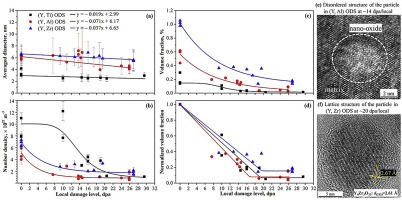Journal of Nuclear Materials ( IF 2.8 ) Pub Date : 2019-12-16 , DOI: 10.1016/j.jnucmat.2019.151953 Peng Song , Akihiko Kimura , Kiyohiro Yabuuchi , Peng Dou , Hideo Watanabe , Jin Gao , Yen-Jui Huang

|
Three types of 15Cr-ODS ferritic steels were irradiated with 6.4 MeV Fe3+ at 200 °C up to a nominal displacement damage of 10 dpa to assess the phase stability of different sorts of oxide particles under ion-irradiation. Before the irradiation, dominant oxide particles in (Y, Ti) ODS, (Y, Al) ODS and (Y, Zr) ODS steels were identified as Y–Ti–O, Y–Al–O, and Y–Zr–O types, respectively, and the difference in the average diameters and number densities of oxide particles among the three ODS ferritic steels was as small as within the factor of two. After the irradiation, the number densities and volume fractions of oxide particles in all the three ODS steels decreased with increasing dpa regardless of the different dispersion morphologies, chemical compositions and crystal structures of the particles, which was interpreted in terms of the dominant mechanism of ballistic dissolution with a moderate occurrence of radiation-enhanced diffusion (RED) and re-precipitation of the nano-clusters. Almost no significant difference in the phase stability of oxide particles was recognized among the three types of ODS ferritic steels. However, normalized volume fractions of Y–Zr–O particles were slightly bigger than those of Y–Ti–O and Y–Al–O at high damage levels. Moreover, Y–Al–O particles underwent the loss of moiré fringe because of the amorphization of oxide particles, while the δ-phase Y4Zr3O12 in (Y, Zr) ODS still maintained crystalline structure even at ∼ 20 dpa/local. It is concluded that Y–Zr–O particles are more stable than Y–Al–O and possibly Y–Ti–O particles.
中文翻译:

在200°C下6.4 MeV Fe离子辐照下,不同类型的15Cr-ODS铁素体钢中氧化物颗粒的相稳定性评估
用6.4 MeV Fe 3+辐照三种类型的15Cr-ODS铁素体钢在200°C到10 dpa的标称位移损伤下评估离子辐照下不同种类氧化物颗粒的相稳定性。在辐照之前,(Y,Ti)ODS,(Y,Al)ODS和(Y,Zr)ODS钢中的主要氧化物颗粒被确定为Y–Ti–O,Y–Al–O和Y–Zr–O三种ODS铁素体钢中氧化物颗粒的平均直径和数量密度的差异分别小至2倍以内。辐照后,所有三种ODS钢中氧化物颗粒的数量密度和体积分数均随着dpa的增加而降低,而与颗粒的分散形态,化学组成和晶体结构不同无关,这是根据弹道溶解的主要机理解释的,其中适度出现了辐射增强扩散(RED)和纳米团簇的再沉淀。在三种类型的ODS铁素体钢之间,几乎没有发现氧化物颗粒的相稳定性有显着差异。但是,在高损伤水平下,Y-Zr-O粒子的归一化体积分数比Y-Ti-O和Y-Al-O归一化体积分数稍大。此外,由于氧化物粒子的非晶化,Y–Al–O粒子遭受了莫尔条纹的损失,而 在高损伤水平下,Y-Zr-O粒子的归一化体积分数略大于Y-Ti-O和Y-Al-O的归一化体积分数。此外,由于氧化物粒子的非晶化,Y–Al–O粒子遭受了莫尔条纹的损失,而 在高损伤水平下,Y-Zr-O粒子的归一化体积分数略大于Y-Ti-O和Y-Al-O的归一化体积分数。此外,由于氧化物粒子的非晶化,Y–Al–O粒子遭受了莫尔条纹的损失,而(Y,Zr)ODS中的δ相Y 4 Zr 3 O 12甚至在约20 dpa / local时仍保持晶体结构。结论是,Y-Zr-O颗粒比Y-Al-O和Y-Ti-O颗粒更稳定。











































 京公网安备 11010802027423号
京公网安备 11010802027423号